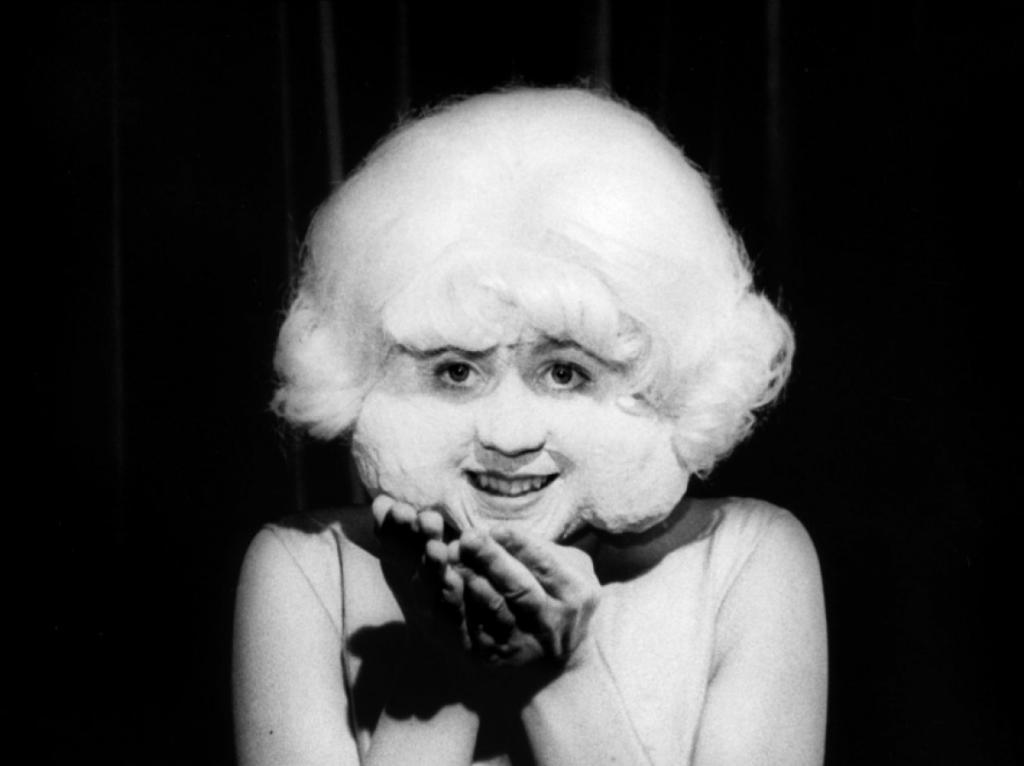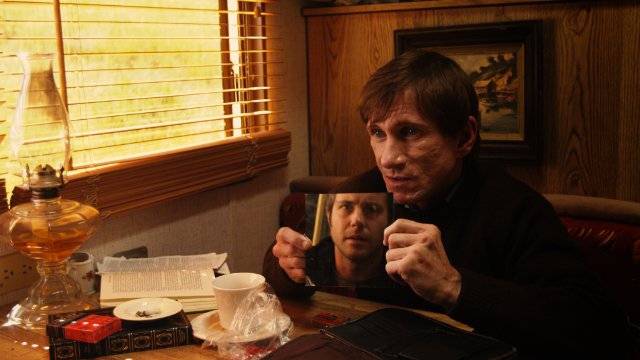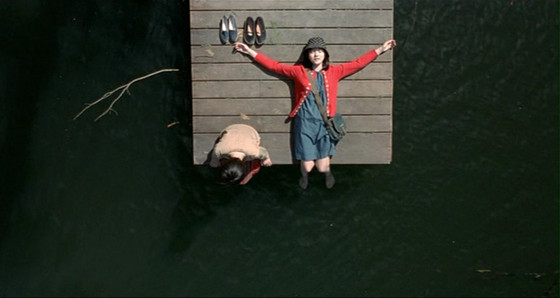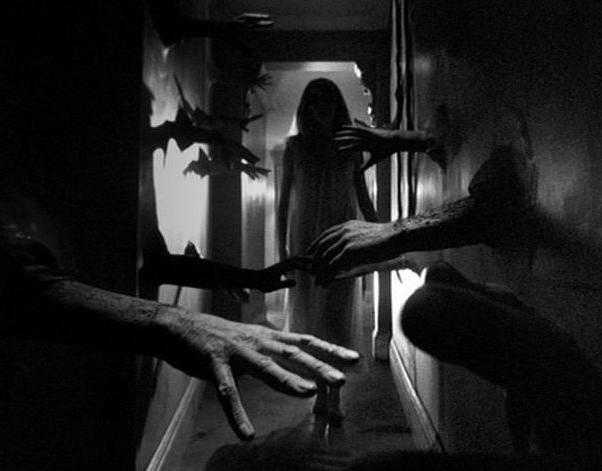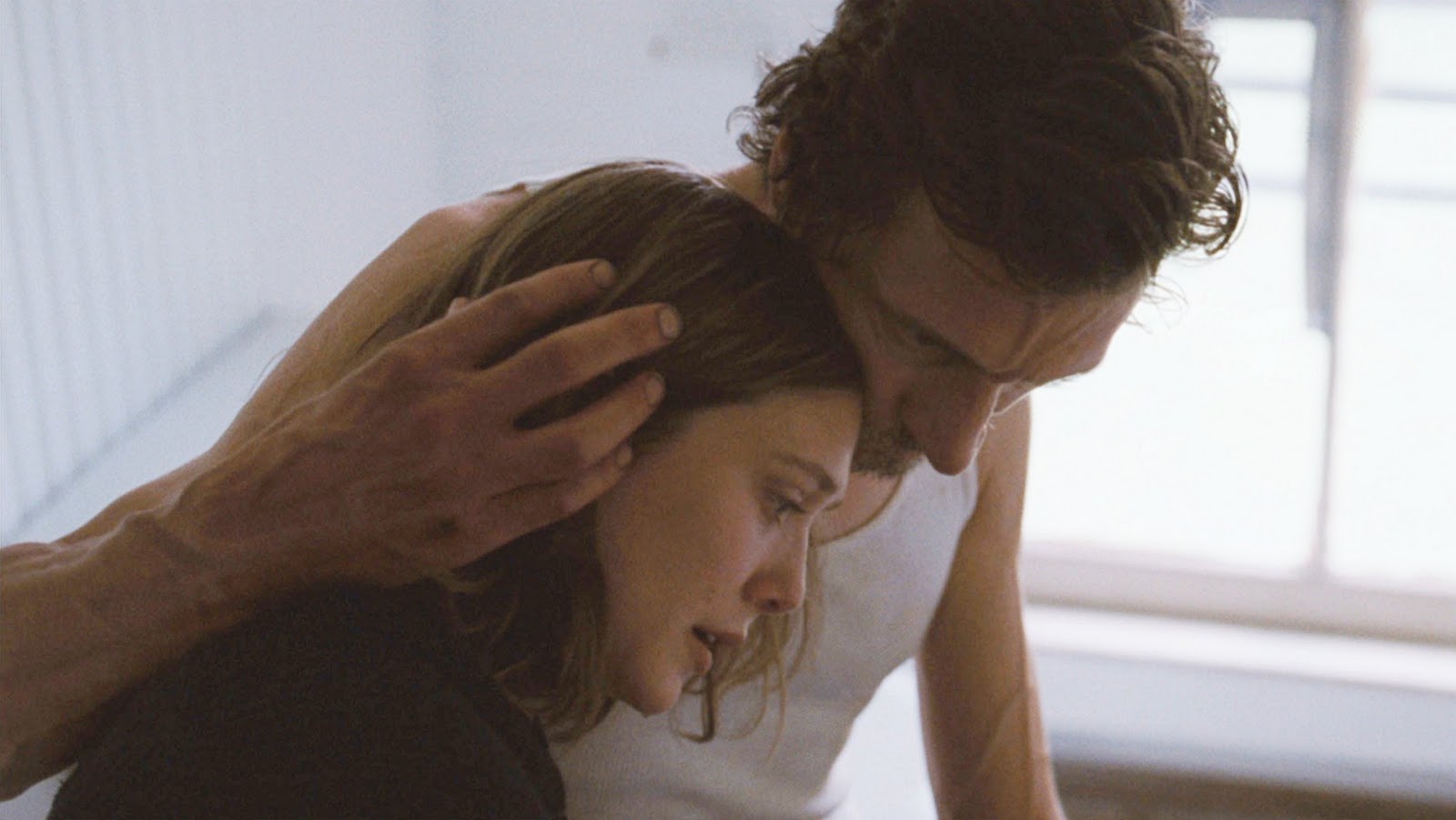6. Eraserhead (David Lynch, 1977)
Director David Lynch hasn’t made a “horror” film per-say. All of his films seem to have a little bit of a horror-element to them, but it wouldn’t make sense to call his 1977 film Eraserhead anything else. The plot’s simple enough though. A simple man who lives in a dirty, run-down apartment finds out that his girlfriend has given birth. But what follows is a bizarre and surreal journey about what happens when you become a parent.
After a strange and confusing opening, we see Henry Spencer (Jack Nance) walking to his apartment with some groceries. As he’s about to enter his room, he is stopped by The Beautiful Girl Across The Hall (Judith Anna Roberts) and is told that his girlfriend, Mary (Charlotte Stewart), has invited him to dinner at her parents house.
Henry arrives at Mary’s house that night and has an awkward conversation with her mother. Once they sit down for dinner, Henry is asked to carve the chicken. When he starts to carve the chicken, it begins to gush blood and writhe in pain. After they eat, Henry is cornered by Mary’s mother and she tells him that Mary has had a child and now they have to get married. The problem is, Mary isn’t even sure if what she had was a child.
To call Eraserhead “one of a kind” is an understatement. You’d be hard pressed to find any other film that compares to it. One thing impressive about it is its budget. David Lynch was able to make such a strange, yet unique film with only $20,000. Even more impressive was that it was even made at all. Production was very slow and Lynch kept running out of money. Because of this, it caused quite a few hiatuses, and in the long run, it took five long years for the film to come out.
Eraserhead takes something as special as becoming a parent and completely turns it on its head. The whole film seems to take place in some sort of half-reality/half-nightmare world and we aren’t sure exactly when we’re in one or the other. This, and Lynch’s refusal to discuss any meaning behind the film itself makes it one of the best “head-scratchers” of all-time.
7. Resolution (Justin Benson, Aaron Moorhead, 2012)
If you had a best friend who was addicted to drugs, wouldn’t you want to do anything you could to help him or her overcome that addiction? No matter what extreme lengths you would have to go to? But what if those extremes turned into something a lot more than what you bargained for? For Michael Danube (Peter Cilella), this is exactly what he’s doing.
Michael is a professional graphic designer who lives in the city with his wife. He randomly receives an email with a video of Chris Daniels (Vinny Curran), his former best friend. Over the years, Chris has become a drug addict and his behavior has become unpredictable. Along with the video, there was a map, and after seeing the video, Michael decides to go and try to help his friend one last time.
When Michael arrives, Chris is outside talking to himself and shooting a pistol. He seems happy to see Michael though so his invites him in. Michael soon brings up the idea of going to rehab, but Chris refuses. Then, out of nowhere, Michael pulls out a stun-gun and stuns Chris. Chris soon wakes up, handcuffed to a pipe. From there, things just get straight-up confusing.
Michael ends up finding some weird and disturbing media such as videos, records, pictures, and books. All seem to be connected to tragic events that are tied to the area around the cabin. Also, when you throw a “UFO religion” into the mix, you can imagine how crazy things are going to get.
Yes, Resolution is confusing. When the ending comes around, you may not even know what just happened. But the best part of this film, is that if you pay enough attention during it, you will know. As an audience, we’re given enough clues to figure out exactly what’s going on, the directors just aren’t holding our hands through the experience. They leave it up to us to put the pieces together and when we do, the payoff is worth it.
8. A Tale Of Two Sisters (Jee-woon Kim, 2003)
If you’ve happened to of seen or heard of the 2009 film The Uninvited, there’s a good chance you might have heard about this film as well. The Uninvited was a remake of Jee-woon Kim’s classic 2003 film A Tale Of Two Sisters. Although the remake was okay in its own way, the original is a truly terrifying ghost story.
Su-mi (Im Soo -jung) returns to her family’s home with her father and her sister, Su-yeon (Moon Geun-young). That night at dinner, the sisters stepmother announces that she has invited their uncle and his wife to dinner the next day. Su-mi tells her stepmother that she refuses to have dinner with them, and her sister and her leave.
Later that night, Su-yeon has terrifying visions and Su-mi dreams about a ghost coming into her room. When their uncle and his wife arrive for dinner, they begin their meal. But then the wife seems to have a violent attack. When she recovers, she says that she saw a girl underneath the sink. Strangely enough, the stepmother says that she saw her too.
It’s difficult to say much else about the plot without somehow unraveling the mystery itself. At some point you may begin to wonder if these things really are happening, or if they’re just in the girls head. But then you may switch back to thinking they’re actually happening. There isn’t much explanation at all when you start getting towards the end, but if you pay enough attention you may be able to figure it out.
It’s currently one the highest-grossing Korean horror films, and it was also the first of its kind to be shown in American theaters. One of the things that can contribute to it’s success is its beautiful photography and production design. And on top of that, it’s original! The story itself is based on the Korean fairy tale, but at a time when Korean cinema was suffering from the same over-used and predictable plots that American cinema was, this was a breath of fresh air to everyone.
9. Repulsion (Roman Polanski, 1965)
The first film in director Roman Polanski’s “apartment trilogy” (followed by Rosemary’s Baby and The Tenant) and his first ever English-language film. This film focuses on a woman who lives with her older sister in London. Her sister goes on vacation, and once left alone, she starts reliving traumatic experiences from her past in strange ways.
Carol Ledoux (Catherine Deneuve) is a manicurist who lives in an apartment in London with her sister Helen (Yvonne Furneaux). Everyday seems to be the exact same routine for Carol. She aimlessly walks through town to her job and back and when she has any kind of interactions with men, they’re very awkward.
Helen decides to go on a vacation with her boyfriend, leaving Carol alone at the apartment. Being alone doesn’t help Carol’s mental state and it begins to show at work, so she is sent home the following day. Once back in her apartment, her behavior becomes even stranger.
There’s a point in the film where Carol begins to see arms and hands reach through the walls of the apartment as well as the walls beginning to crack and break apart. The effects that are used here are so impressive for a film that came out in 1965. When watching, you may even forget for a second that it didn’t just recently came out.
Not very “dialogue-heavy,” Polanski instead tells the story of Carol’s descent into madness with the use of sounds and her actions. He is able to pair these two things to the visuals of Carol’s mindset so well that that you may begin feeling as “repulsed” as she does by whatever has caused her psychosis.
10. Martha Marcy May Marlene (Sean Durkin, 2011)
Martha Marcy May Marlene, on its surface, is a “thriller/mystery.” It may not have the blood, gore, and scares as most traditional horror films, but when you consider the actual subject matter, you’d be hard-pressed to call it anything but a horror story. It follows a young girl who escapes from a strange cult to live with her sister. But she seems to find it difficult to integrate herself back into the conventional American society.
Martha (Elizabeth Olsen) flees from a cult early one morning until she reaches a phone. She then calls her sister Lucy (Sarah Paulson) to ask her for help. Lucy picks Martha up at a nearby bus station to take her back to her home which she shares with her husband Patrick (Hugh Dancy). When asked about where she has been, Martha just tells her sister that she had been living in the Catskill Mountains with her boyfriend. She doesn’t mention the cult at all.
The rest of the film is told through a series flash-backs of Martha’s time in the cult and her time in present day with her sister and brother-in-law. We see the strange and traumatizing events that she had gone through during her time in the Catskill Mountains. Events that, at first to anyone, would be terrifying and awful. But as Martha spends more time with the cult, the more she begins to get used to that way of life. She even begins introducing new women to the cult as well.
Yes, Martha has physically escaped the cult, it’s escaping it in her mind that she finds difficult. She may be back into normal society but the trauma she had suffered from her time with the cult may be too difficult to overcome. That, coupled with the fact the she believes the cult members are following her and want her back may make it impossible for her to lead a normal life again.
Author Bio: Adam Ripley has a Bachelor’s Degree in Applied Communications, and he loves all things horror and all things music.
